Yangyifei Luo
XRAG: eXamining the Core -- Benchmarking Foundational Components in Advanced Retrieval-Augmented Generation
Dec 24, 2024Abstract:Retrieval-augmented generation (RAG) synergizes the retrieval of pertinent data with the generative capabilities of Large Language Models (LLMs), ensuring that the generated output is not only contextually relevant but also accurate and current. We introduce XRAG, an open-source, modular codebase that facilitates exhaustive evaluation of the performance of foundational components of advanced RAG modules. These components are systematically categorized into four core phases: pre-retrieval, retrieval, post-retrieval, and generation. We systematically analyse them across reconfigured datasets, providing a comprehensive benchmark for their effectiveness. As the complexity of RAG systems continues to escalate, we underscore the critical need to identify potential failure points in RAG systems. We formulate a suite of experimental methodologies and diagnostic testing protocols to dissect the failure points inherent in RAG engineering. Subsequently, we proffer bespoke solutions aimed at bolstering the overall performance of these modules. Our work thoroughly evaluates the performance of advanced core components in RAG systems, providing insights into optimizations for prevalent failure points.
MKGL: Mastery of a Three-Word Language
Oct 10, 2024



Abstract:Large language models (LLMs) have significantly advanced performance across a spectrum of natural language processing (NLP) tasks. Yet, their application to knowledge graphs (KGs), which describe facts in the form of triplets and allow minimal hallucinations, remains an underexplored frontier. In this paper, we investigate the integration of LLMs with KGs by introducing a specialized KG Language (KGL), where a sentence precisely consists of an entity noun, a relation verb, and ends with another entity noun. Despite KGL's unfamiliar vocabulary to the LLM, we facilitate its learning through a tailored dictionary and illustrative sentences, and enhance context understanding via real-time KG context retrieval and KGL token embedding augmentation. Our results reveal that LLMs can achieve fluency in KGL, drastically reducing errors compared to conventional KG embedding methods on KG completion. Furthermore, our enhanced LLM shows exceptional competence in generating accurate three-word sentences from an initial entity and interpreting new unseen terms out of KGs.
MIKO: Multimodal Intention Knowledge Distillation from Large Language Models for Social-Media Commonsense Discovery
Feb 29, 2024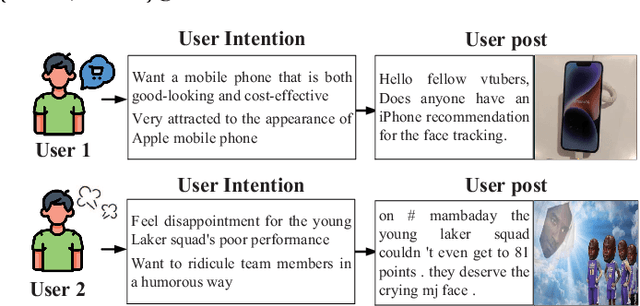

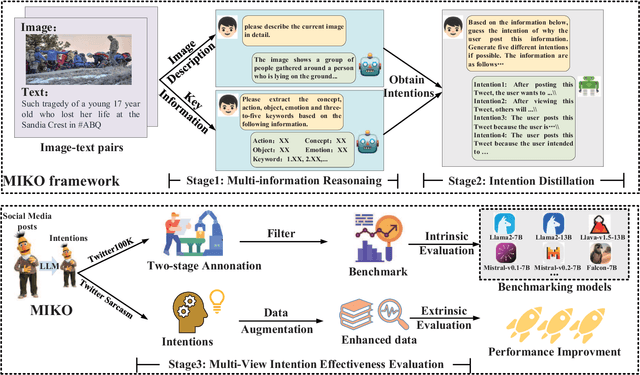

Abstract:Social media has become a ubiquitous tool for connecting with others, staying updated with news, expressing opinions, and finding entertainment. However, understanding the intention behind social media posts remains challenging due to the implicitness of intentions in social media posts, the need for cross-modality understanding of both text and images, and the presence of noisy information such as hashtags, misspelled words, and complicated abbreviations. To address these challenges, we present MIKO, a Multimodal Intention Kowledge DistillatiOn framework that collaboratively leverages a Large Language Model (LLM) and a Multimodal Large Language Model (MLLM) to uncover users' intentions. Specifically, we use an MLLM to interpret the image and an LLM to extract key information from the text and finally instruct the LLM again to generate intentions. By applying MIKO to publicly available social media datasets, we construct an intention knowledge base featuring 1,372K intentions rooted in 137,287 posts. We conduct a two-stage annotation to verify the quality of the generated knowledge and benchmark the performance of widely used LLMs for intention generation. We further apply MIKO to a sarcasm detection dataset and distill a student model to demonstrate the downstream benefits of applying intention knowledge.
ASGEA: Exploiting Logic Rules from Align-Subgraphs for Entity Alignment
Feb 16, 2024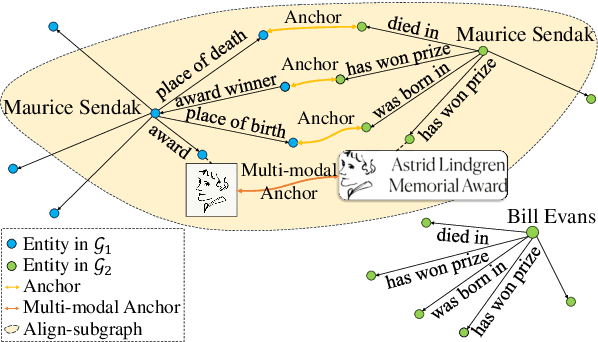
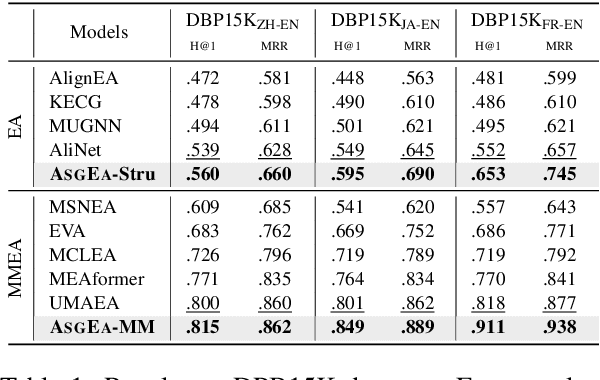
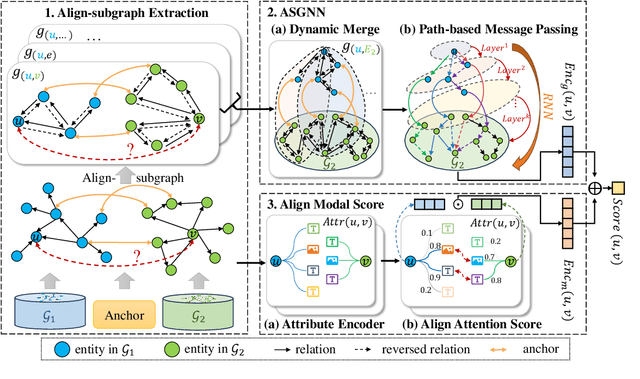
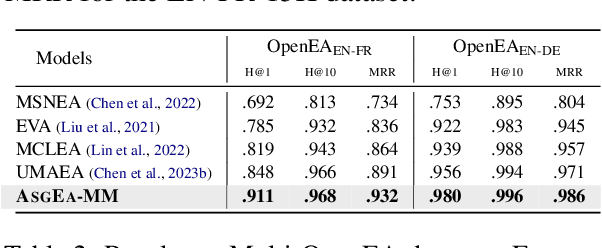
Abstract:Entity alignment (EA) aims to identify entities across different knowledge graphs that represent the same real-world objects. Recent embedding-based EA methods have achieved state-of-the-art performance in EA yet faced interpretability challenges as they purely rely on the embedding distance and neglect the logic rules behind a pair of aligned entities. In this paper, we propose the Align-Subgraph Entity Alignment (ASGEA) framework to exploit logic rules from Align-Subgraphs. ASGEA uses anchor links as bridges to construct Align-Subgraphs and spreads along the paths across KGs, which distinguishes it from the embedding-based methods. Furthermore, we design an interpretable Path-based Graph Neural Network, ASGNN, to effectively identify and integrate the logic rules across KGs. We also introduce a node-level multi-modal attention mechanism coupled with multi-modal enriched anchors to augment the Align-Subgraph. Our experimental results demonstrate the superior performance of ASGEA over the existing embedding-based methods in both EA and Multi-Modal EA (MMEA) tasks. Our code will be available soon.
Attribute-Consistent Knowledge Graph Representation Learning for Multi-Modal Entity Alignment
Apr 04, 2023Abstract:The multi-modal entity alignment (MMEA) aims to find all equivalent entity pairs between multi-modal knowledge graphs (MMKGs). Rich attributes and neighboring entities are valuable for the alignment task, but existing works ignore contextual gap problems that the aligned entities have different numbers of attributes on specific modality when learning entity representations. In this paper, we propose a novel attribute-consistent knowledge graph representation learning framework for MMEA (ACK-MMEA) to compensate the contextual gaps through incorporating consistent alignment knowledge. Attribute-consistent KGs (ACKGs) are first constructed via multi-modal attribute uniformization with merge and generate operators so that each entity has one and only one uniform feature in each modality. The ACKGs are then fed into a relation-aware graph neural network with random dropouts, to obtain aggregated relation representations and robust entity representations. In order to evaluate the ACK-MMEA facilitated for entity alignment, we specially design a joint alignment loss for both entity and attribute evaluation. Extensive experiments conducted on two benchmark datasets show that our approach achieves excellent performance compared to its competitors.
 Add to Chrome
Add to Chrome Add to Firefox
Add to Firefox Add to Edge
Add to Edge